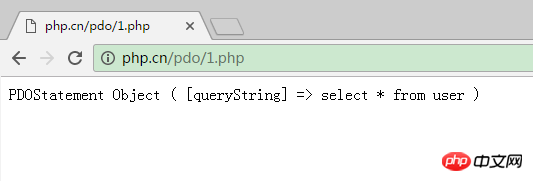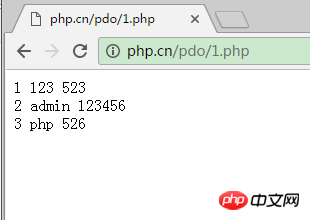Three ways to execute SQL statements in PDO
Three ways to execute SQL statements in PDO
In PDO, we can use three ways to execute SQL statements, namely exec() method, query method, and prepared statement prepare() and execute() methods~
In the previous article "Using the PDO constructor to connect to the database and DSN detailed explanation", we introduced Now that we have a detailed explanation of how to use constructors to connect databases and DSNs, this article will introduce to you three ways to execute SQL statements in PDO. We will introduce them one by one below!
First method: exec() method
#The exec() method returns the number of rows affected after executing the SQL statement, its syntax The format is as follows:
int PDO::exec(string statement)
The parameter satatement is the SQL statement to be executed. This method returns the number of rows affected when executing the SQL statement. It is usually used in INSERT, DELETE and UPDATE statements. Let's explain it with specific code. The code is as follows:
<?php
header("Content-Type:text/html; charset=utf-8"); //设置页面的编码格式
$dbms = "mysql"; // 数据库的类型
$dbName ="php_cn"; //使用的数据库名称
$user = "root"; //使用的数据库用户名
$pwd = "root"; //使用的数据库密码
$host = "localhost"; //使用的主机名称
$dsn = "$dbms:host=$host;dbName=$dbName ";
try{ //捕获异常
$pdo = new PDO($dsn,$user,$pwd); //实例化对象
$query="insert into user(username,password) values('php','523')";//需要执行的sql语句
$res=$pdo->exec($query);//执行添加语句并返回受影响行数
echo "数据添加成功,受影响行数为: ".$res;
}catch(Exception $e){
die("Error!:".$e->getMessage().'<br>');
}
?>The output result is:

Second method: query() Method
query() method is used to return the result set after executing the query. The syntax format of this function is as follows:
PDOStatement PDO::query(string statement)
The parameter satatement is the SQL statement to be executed , it returns a PODStatement object! Please see the sample code below for details:
<?php
header("Content-Type:text/html; charset=utf-8"); //设置页面的编码格式
$dbms = "mysql"; // 数据库的类型
$dbName ="php_cn"; //使用的数据库名称
$user = "root"; //使用的数据库用户名
$pwd = "root"; //使用的数据库密码
$host = "localhost"; //使用的主机名称
$dsn = "$dbms:host=$host;dbName=$dbName ";
try{
$pdo=new PDO($dsn,$user,$pwd);
$query="select * from user";
$res=$pdo->query($query);
print_r($res);
}catch(Exception $e){
die("Error!:".$e->getMessage().'<br>');
}
?>The output result is:

##Note:
1. Both query and exec can execute all sql statements, but the return values are different.
2. Query can realize all exec functions.
3. When applying the select statement to exec, it always returns 0
4. If you want to see the specific results of the query, you can Complete the loop output through the foreach statement
The third method: prepared statements: prepare() statement and execute() Statement
Preprocessing statements include two methods: prepare() and execute(). First, prepare the query through the prepare() method, and then execute the query through the execute() method. You can also bind parameters to the execute() method through the bindParam() method. The syntax is as follows:
PDOStatement PDO::prepare(string statement[,array driver_options]) bool PDOStatement::execute([array input_parameters])
<?php
header("Content-Type:text/html; charset=utf-8"); //设置页面的编码格式
$dbms = "mysql"; // 数据库的类型
$dbName ="php_cn"; //使用的数据库名称
$user = "root"; //使用的数据库用户名
$pwd = "root"; //使用的数据库密码
$host = "localhost"; //使用的主机名称
$dsn = "$dbms:host=$host;dbname=$dbName";
try{
$pdo=new PDO($dsn,$user,$pwd);//初始化一个PDO对象,就是创建了数据库连接对象$pdo
$query="select * from user";//需要执行的sql语句
$res=$pdo->prepare($query);//准备查询语句
$res->execute();
while($result=$res->fetch(PDO::FETCH_ASSOC)){
echo $result['id']." ".$result['username']." ".$result['password'].'<br>';
}
}catch(Exception $e){
die("Error!:".$e->getMessage().'<br>');
}
Detailed Explanation of the fetch() Method of Obtaining the Result Set in PDO"!
The above is the detailed content of Three ways to execute SQL statements in PDO. For more information, please follow other related articles on the PHP Chinese website!

Hot AI Tools

Undresser.AI Undress
AI-powered app for creating realistic nude photos

AI Clothes Remover
Online AI tool for removing clothes from photos.

Undress AI Tool
Undress images for free

Clothoff.io
AI clothes remover

Video Face Swap
Swap faces in any video effortlessly with our completely free AI face swap tool!

Hot Article

Hot Tools

Notepad++7.3.1
Easy-to-use and free code editor

SublimeText3 Chinese version
Chinese version, very easy to use

Zend Studio 13.0.1
Powerful PHP integrated development environment

Dreamweaver CS6
Visual web development tools

SublimeText3 Mac version
God-level code editing software (SublimeText3)

Hot Topics
 Can I install mysql on Windows 7
Apr 08, 2025 pm 03:21 PM
Can I install mysql on Windows 7
Apr 08, 2025 pm 03:21 PM
Yes, MySQL can be installed on Windows 7, and although Microsoft has stopped supporting Windows 7, MySQL is still compatible with it. However, the following points should be noted during the installation process: Download the MySQL installer for Windows. Select the appropriate version of MySQL (community or enterprise). Select the appropriate installation directory and character set during the installation process. Set the root user password and keep it properly. Connect to the database for testing. Note the compatibility and security issues on Windows 7, and it is recommended to upgrade to a supported operating system.
 How to create tables with sql server using sql statement
Apr 09, 2025 pm 03:48 PM
How to create tables with sql server using sql statement
Apr 09, 2025 pm 03:48 PM
How to create tables using SQL statements in SQL Server: Open SQL Server Management Studio and connect to the database server. Select the database to create the table. Enter the CREATE TABLE statement to specify the table name, column name, data type, and constraints. Click the Execute button to create the table.
 How to judge SQL injection
Apr 09, 2025 pm 04:18 PM
How to judge SQL injection
Apr 09, 2025 pm 04:18 PM
Methods to judge SQL injection include: detecting suspicious input, viewing original SQL statements, using detection tools, viewing database logs, and performing penetration testing. After the injection is detected, take measures to patch vulnerabilities, verify patches, monitor regularly, and improve developer awareness.
 Does mysql optimize lock tables
Apr 08, 2025 pm 01:51 PM
Does mysql optimize lock tables
Apr 08, 2025 pm 01:51 PM
MySQL uses shared locks and exclusive locks to manage concurrency, providing three lock types: table locks, row locks and page locks. Row locks can improve concurrency, and use the FOR UPDATE statement to add exclusive locks to rows. Pessimistic locks assume conflicts, and optimistic locks judge the data through the version number. Common lock table problems manifest as slow querying, use the SHOW PROCESSLIST command to view the queries held by the lock. Optimization measures include selecting appropriate indexes, reducing transaction scope, batch operations, and optimizing SQL statements.
 How to check SQL statements
Apr 09, 2025 pm 04:36 PM
How to check SQL statements
Apr 09, 2025 pm 04:36 PM
The methods to check SQL statements are: Syntax checking: Use the SQL editor or IDE. Logical check: Verify table name, column name, condition, and data type. Performance Check: Use EXPLAIN or ANALYZE to check indexes and optimize queries. Other checks: Check variables, permissions, and test queries.
 How to write a tutorial on how to connect three tables in SQL statements
Apr 09, 2025 pm 02:03 PM
How to write a tutorial on how to connect three tables in SQL statements
Apr 09, 2025 pm 02:03 PM
This article introduces a detailed tutorial on joining three tables using SQL statements to guide readers step by step how to effectively correlate data in different tables. With examples and detailed syntax explanations, this article will help you master the joining techniques of tables in SQL, so that you can efficiently retrieve associated information from the database.
 How to recover data after SQL deletes rows
Apr 09, 2025 pm 12:21 PM
How to recover data after SQL deletes rows
Apr 09, 2025 pm 12:21 PM
Recovering deleted rows directly from the database is usually impossible unless there is a backup or transaction rollback mechanism. Key point: Transaction rollback: Execute ROLLBACK before the transaction is committed to recover data. Backup: Regular backup of the database can be used to quickly restore data. Database snapshot: You can create a read-only copy of the database and restore the data after the data is deleted accidentally. Use DELETE statement with caution: Check the conditions carefully to avoid accidentally deleting data. Use the WHERE clause: explicitly specify the data to be deleted. Use the test environment: Test before performing a DELETE operation.
 Do mysql need to pay
Apr 08, 2025 pm 05:36 PM
Do mysql need to pay
Apr 08, 2025 pm 05:36 PM
MySQL has a free community version and a paid enterprise version. The community version can be used and modified for free, but the support is limited and is suitable for applications with low stability requirements and strong technical capabilities. The Enterprise Edition provides comprehensive commercial support for applications that require a stable, reliable, high-performance database and willing to pay for support. Factors considered when choosing a version include application criticality, budgeting, and technical skills. There is no perfect option, only the most suitable option, and you need to choose carefully according to the specific situation.






